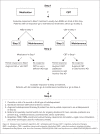Current diagnosis and treatment of anxiety disorders
- PMID: 23599668
- PMCID: PMC3628173
Current diagnosis and treatment of anxiety disorders
Abstract
Anxiety disorders are the most prevalent mental health conditions. Although they are less visible than schizophrenia, depression, and bipolar disorder, they can be just as disabling. The diagnoses of anxiety disorders are being continuously revised. Both dimensional and structural diagnoses have been used in clinical treatment and research, and both methods have been proposed for the new classification in the Diagnostic and Statistical Manual of Mental Disorders IV (DSM-5). However, each of these approaches has limitations. More recently, the emphasis in diagnosis has focused on neuroimaging and genetic research. This approach is based partly on the need for a more comprehensive understanding of how biology, stress, and genetics interact to shape the symptoms of anxiety. Anxiety disorders can be effectively treated with psychopharmacological and cognitive-behavioral interventions. These inter ventions have different symptom targets; thus, logical combinations of these strategies need to be further studied in order to improve future outcomes. New developments are forthcoming in the field of alternative strategies for managing anxiety and for treatment-resistant cases. Additional treatment enhancements should include the development of algorithms that can be easily used in primary care and with greater focus on managing functional impairment in patients with anxiety.
Figures


References
-
- Kessler RC, McGonagle KA, Zhao S, et al. Lifetime and 12-month prevalence of DSM-III-R psychiatric disorders in the United States: Results from the National Comorbidity Survey. Arch Gen Psychiatry. 1994;51(1):8–19. - PubMed
-
- Weissman MM, Merikangas KR. The epidemiology of anxiety and panic disorders: An update. J Clin Psychiatry. 1986;(47 Suppl):11–17. - PubMed
-
- Stein MB, Sherbourne MG, Craske MG, et al. Quality of care for primary care patients with anxiety disorders. Am J Psychiatry. 2004;161(12):2230–2237. - PubMed
-
- Leon AC, Portera L, Weissman MM. The social costs of anxiety disorders. Br J Psychiatry Suppl. 1995;(27):19–22. - PubMed
LinkOut - more resources
Full Text Sources
